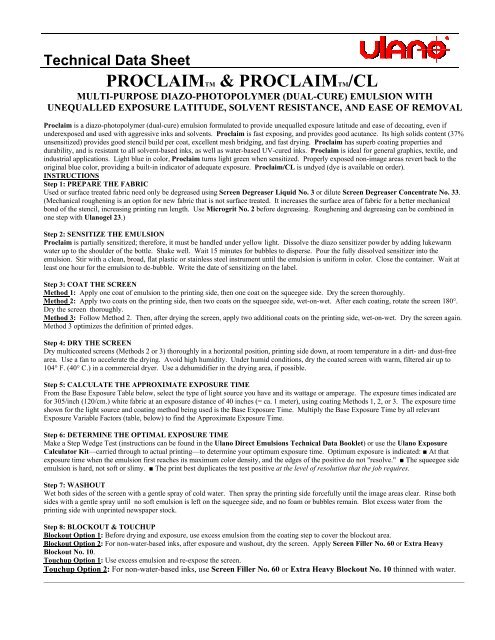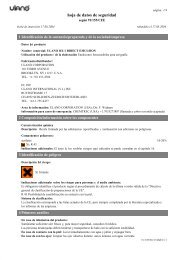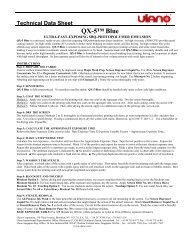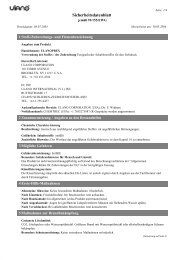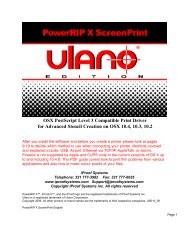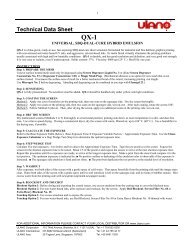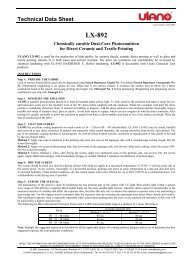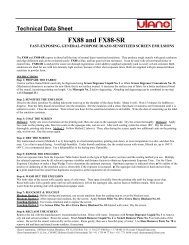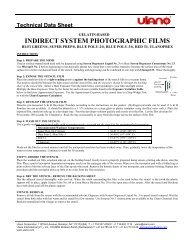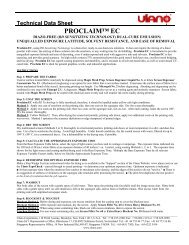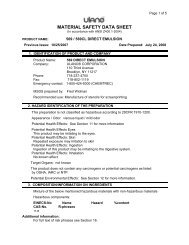You also want an ePaper? Increase the reach of your titles
YUMPU automatically turns print PDFs into web optimized ePapers that Google loves.
Technical Data Sheet<br />
PRO<strong>CL</strong>AIMTM & PRO<strong>CL</strong>AIMTM/<strong>CL</strong><br />
MULTI-PURPOSE DIAZO-PHOTOPOLYMER (DUAL-CURE) EMULSION WITH<br />
UNEQUALLED EXPOSURE LATITUDE, SOLVENT RESISTANCE, AND EASE OF REMOVAL<br />
<strong>Proclaim</strong> is a diazo-photopolymer (dual-cure) emulsion formulated to provide unequalled exposure latitude <strong>and</strong> ease of decoating, even if<br />
underexposed <strong>and</strong> used with aggressive inks <strong>and</strong> solvents. <strong>Proclaim</strong> is fast exposing, <strong>and</strong> provides good acutance. Its high solids content (37%<br />
unsensitized) provides good stencil build per coat, excellent mesh bridging, <strong>and</strong> fast drying. <strong>Proclaim</strong> has superb coating properties <strong>and</strong><br />
durability, <strong>and</strong> is resistant to all solvent-based inks, as well as water-based UV-cured inks. <strong>Proclaim</strong> is ideal for general graphics, textile, <strong>and</strong><br />
industrial applications. Light blue in color, <strong>Proclaim</strong> turns light green when sensitized. Properly exposed non-image areas revert back to the<br />
original blue color, providing a built-in indicator of adequate exposure. <strong>Proclaim</strong>/<strong>CL</strong> is undyed (dye is available on order).<br />
INSTRUCTIONS<br />
Step 1: PREPARE THE FABRIC<br />
Used or surface treated fabric need only be degreased using Screen Degreaser Liquid No. 3 or dilute Screen Degreaser Concentrate No. 33.<br />
(Mechanical roughening is an option for new fabric that is not surface treated. It increases the surface area of fabric for a better mechanical<br />
bond of the stencil, increasing printing run length. Use Microgrit No. 2 before degreasing. Roughening <strong>and</strong> degreasing can be combined in<br />
one step with Ulanogel 23.)<br />
Step 2: SENSITIZE THE EMULSION<br />
<strong>Proclaim</strong> is partially sensitized; therefore, it must be h<strong>and</strong>led under yellow light. Dissolve the diazo sensitizer powder by adding lukewarm<br />
water up to the shoulder of the bottle. Shake well. Wait 15 minutes for bubbles to disperse. Pour the fully dissolved sensitizer into the<br />
emulsion. Stir with a clean, broad, flat plastic or stainless steel instrument until the emulsion is uniform in color. Close the container. Wait at<br />
least one hour for the emulsion to de-bubble. Write the date of sensitizing on the label.<br />
Step 3: COAT THE SCREEN<br />
Method 1: Apply one coat of emulsion to the printing side, then one coat on the squeegee side. Dry the screen thoroughly.<br />
Method 2: Apply two coats on the printing side, then two coats on the squeegee side, wet-on-wet. After each coating, rotate the screen 180°.<br />
Dry the screen thoroughly.<br />
Method 3: Follow Method 2. Then, after drying the screen, apply two additional coats on the printing side, wet-on-wet. Dry the screen again.<br />
Method 3 optimizes the definition of printed edges.<br />
Step 4: DRY THE SCREEN<br />
Dry multicoated screens (Methods 2 or 3) thoroughly in a horizontal position, printing side down, at room temperature in a dirt- <strong>and</strong> dust-free<br />
area. Use a fan to accelerate the drying. Avoid high humidity. Under humid conditions, dry the coated screen with warm, filtered air up to<br />
104° F. (40° C.) in a commercial dryer. Use a dehumidifier in the drying area, if possible.<br />
Step 5: CALCULATE THE APPROXIMATE EXPOSURE TIME<br />
From the Base Exposure Table below, select the type of light source you have <strong>and</strong> its wattage or amperage. The exposure times indicated are<br />
for 305/inch (120/cm.) white fabric at an exposure distance of 40 inches (= ca. 1 meter), using coating Methods 1, 2, or 3. The exposure time<br />
shown for the light source <strong>and</strong> coating method being used is the Base Exposure Time. Multiply the Base Exposure Time by all relevant<br />
Exposure Variable Factors (table, below) to find the Approximate Exposure Time.<br />
Step 6: DETERMINE THE OPTIMAL EXPOSURE TIME<br />
Make a Step Wedge Test (instructions can be found in the Ulano Direct Emulsions Technical Data Booklet) or use the Ulano Exposure<br />
Calculator Kit—carried through to actual printing—to determine your optimum exposure time. Optimum exposure is indicated: ■ At that<br />
exposure time when the emulsion first reaches its maximum color density, <strong>and</strong> the edges of the positive do not "resolve." ■ The squeegee side<br />
emulsion is hard, not soft or slimy. ■ The print best duplicates the test positive at the level of resolution that the job requires.<br />
Step 7: WASHOUT<br />
Wet both sides of the screen with a gentle spray of cold water. Then spray the printing side forcefully until the image areas clear. Rinse both<br />
sides with a gentle spray until no soft emulsion is left on the squeegee side, <strong>and</strong> no foam or bubbles remain. Blot excess water from the<br />
printing side with unprinted newspaper stock.<br />
Step 8: BLOCKOUT & TOUCHUP<br />
Blockout Option 1: Before drying <strong>and</strong> exposure, use excess emulsion from the coating step to cover the blockout area.<br />
Blockout Option 2: For non-water-based inks, after exposure <strong>and</strong> washout, dry the screen. Apply Screen Filler No. 60 or Extra Heavy<br />
Blockout No. 10.<br />
Touchup Option 1: Use excess emulsion <strong>and</strong> re-expose the screen.<br />
Touchup Option 2: For non-water-based inks, use Screen Filler No. 60 or Extra Heavy Blockout No. 10 thinned with water.<br />
________________________________________________________________________________________________________
2<br />
Technical Data Sheet<br />
Ulano Corporation, 110 Third Avenue, Brooklyn, NY 11217 (USA). Tel: +1 718 237 4700 Fax: +1 718 802-1119 E-mail:<br />
Ulano International (V.I.), Inc., CH-8952 Schlieren-Zurich (Switzerl<strong>and</strong>). Tel: +41 1 755 44 77 Fax: +41 1<br />
733 16 06 E-mail: <br />
Step 9: STENCIL REMOVAL<br />
Remove ink from the screen using the solvent or solvent blend recommended by the ink manufacturer. Use Screen<br />
Degreaser Liquid No. 3 to help remove ink <strong>and</strong> solvent residues that might impair the action of the stencil remover. Brush<br />
Stencil Remover Liquid No. 4 or Stencil Remover Paste No. 5 on both sides of the screen. Do not let the stencil remover<br />
dry on the screen. Wash the screen with a forceful spray of water. Use Haze Remover No. 78 or Ghost Remover with<br />
Ghost Remover Activator to remove ink <strong>and</strong> haze residues, if necessary.<br />
BASE EXPOSURE TABLE (For 305 threads/in.(120/cm.) white polyester or nylon at 40 in. (100 cm.) exposure distance.<br />
LIGHT SOURCE Coating Method 1 Coating Method 2 Coating Method 3<br />
Carbon Arc<br />
15 amps 232 sec 11.5 min 15.5 min<br />
30 amps 116 sec 348 sec 464 sec<br />
40 amps 87 sec 261 sec 348 sec<br />
60 amps 58 sec 174 sec 232 sec<br />
110 amps 32 sec 95 sec 127 sec<br />
Metal Halide<br />
1000 watts 50 sec 145 sec 190 sec<br />
2000 watts 25 sec 73 sec 95 sec<br />
3000 watts 17 sec 48 sec 63 sec<br />
4000 watts 13 sec 36 sec. 48 sec.<br />
5000 watts 10 sec. 29 sec. 38 sec.<br />
Pulsed Xenon<br />
2000 watts 136 sec. 404 sec. 548 sec.<br />
5000 watts 55 sec. 162 sec. 220 sec.<br />
8000 watts 34 sec. 101 sec. 137 sec.<br />
Mercury Vapor<br />
125 watts 9 min 26.5 min NR<br />
1000 watts 66 sec. 198 sec. 266 sec.<br />
2000 watts 33 sec. 99 sec. 133 sec.<br />
4000 watts 17 sec. 50 sec. 67 sec.<br />
Fluorescent Tubes*<br />
40 watts 4 min. 10 min. NR<br />
*Base exposure times are for unfiltered black light, or super diazo blue tubes at 4 – 6 inc. (10 – 15 cm.) exposure distance.<br />
For plant-light, filtered black light, <strong>and</strong> "daylight" fluorescent tubes, use at least double the exposure distance.<br />
EXPOSURE VARIABLES<br />
Distance Factors Fabric Factors High Humidity<br />
0.5 m = 0.25 Steel = 2.0 – 4.0 1.3 – 1.8<br />
0.7 m = 0.49 Dyed = 1.5 – 2.0 Taped (Montage) Positives<br />
1.0 m = 1.0 coarser than 120/cm = 1.1 – 2.0 1.2 – 1.3<br />
2.0 m = 4.0 finer than 120/cm = 0.7 – 0.9 Vellum Positives<br />
1.3 – 1.5<br />
STORAGE: Unsensitized: 1 year<br />
Sensitized: 4- 6 weeks (at 20-25°C) Storage of coated screens: 4 weeks (at 20-25° C in total darkness). Note: During the<br />
Storage of the coated screens, the emulsion can absorb moisture from the air; therefore, we recommend another drying prior to the<br />
exposure. For additional information, consult the Ulano Direct Emulsions Technical Data Book for processing suggestions <strong>and</strong><br />
tips procedures for making a Step Wedge Test, <strong>and</strong> additional information on the Ulano Chemical Line.<br />
Ulano Corporation, 110Third Avenue, Brooklyn, NY 11217(USA). Tel: +1 718 237 4700 Fax: +1 718 802 1119 e-mail: Ulano@Ulano.com<br />
Ulano International (V.I.), Inc., CH-8952 Schlieren-Zurich (Switzerl<strong>and</strong>) Tel: +41 1 755 44 77 Fax + 41 1 773 16 06 e-mail: ulanoeurope@Ulano.com<br />
<strong>Proclaim</strong> <strong>and</strong> <strong>CL</strong> Technical Data Sheet 2004<br />
304dm


